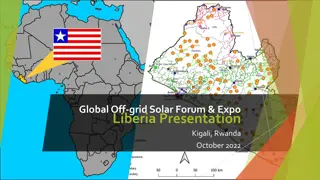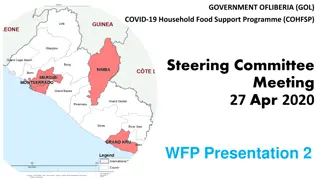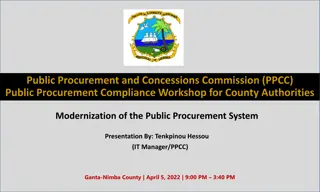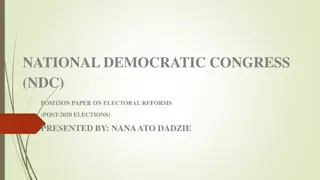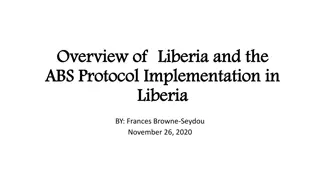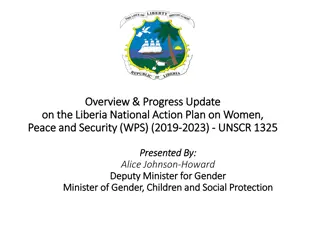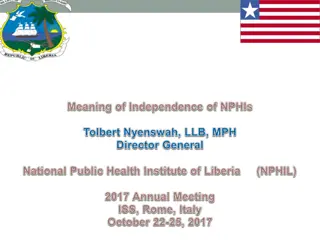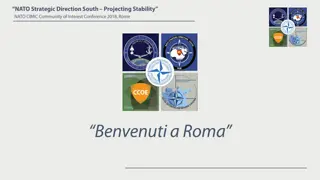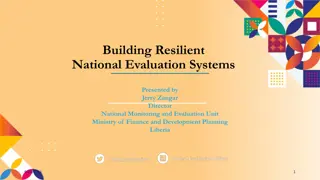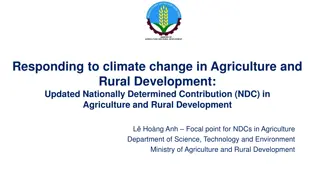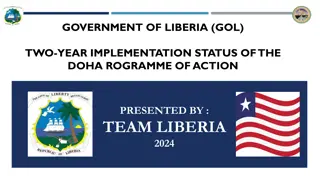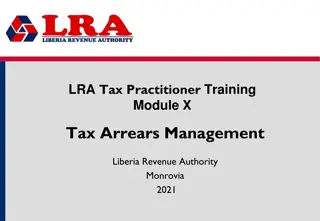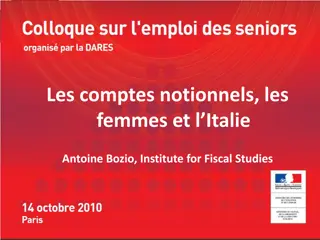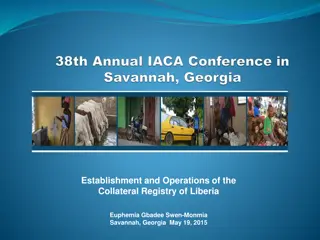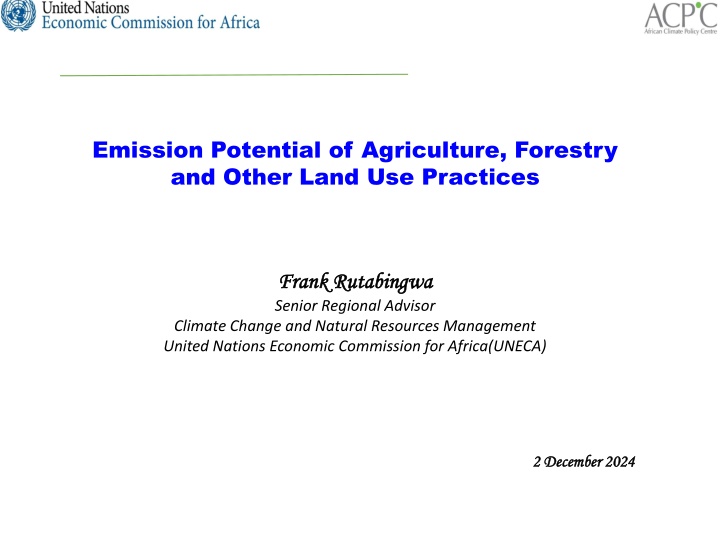
Understanding the Emission Potential of Agriculture, Forestry, and Land Use Practices
Explore the emission potential of agriculture, forestry, and land use practices with insights from Frank Rutabingwa, a Senior Regional Advisor at UNECA. Delve into GHG emissions data, Liberia's CO2 emissions, renewable energy production, and the importance of enhancing NDCs to combat global warming effectively.
Download Presentation

Please find below an Image/Link to download the presentation.
The content on the website is provided AS IS for your information and personal use only. It may not be sold, licensed, or shared on other websites without obtaining consent from the author. If you encounter any issues during the download, it is possible that the publisher has removed the file from their server.
You are allowed to download the files provided on this website for personal or commercial use, subject to the condition that they are used lawfully. All files are the property of their respective owners.
The content on the website is provided AS IS for your information and personal use only. It may not be sold, licensed, or shared on other websites without obtaining consent from the author.
E N D
Presentation Transcript
Emission Potential of Agriculture, Forestry and Other Land Use Practices Frank Rutabingwa Frank Rutabingwa Senior Regional Advisor Climate Change and Natural Resources Management United Nations Economic Commission for Africa(UNECA) 2 December 2024 2 December 2024
Outline Outline General information on GHG emissions General information on GHG emissions AFOLU AFOLU Key summary of Liberia NDC Key summary of Liberia NDC AFOLU initiatives in Liberia s NDC AFOLU initiatives in Liberia s NDC Additional initiatives for consideration Additional initiatives for consideration
Carbon Dioxide Emissions- Fossil Fuels (2022) Data Source: EIA, 2024
Liberias CO2 emission from Fossil Fuels Emission (MMTCo2) 2 1.8 1.6 1.4 1.2 1 0.8 0.6 0.4 0.2 0 1980 1983 1986 1989 1992 1995 1998 2001 2004 2007 2010 2013 2016 2019 2022 Emission (MTCo2) Data Source: EIA, 2024
Total energy production from renewables (hydroelectric, and non-hydroelectric renewable) Renewable Energy (GWH) Rank Country Renewable Energy (GWH) 31 13 12 11 10 9 8 7 6 5 4 3 2 1 Liberia Zimbabwe Morocco Ghana Nigeria DRC Sudan Kenya Angola Ethiopia Mozambique Zambia South Africa Egypt 534.00 6166.58 7585.85 7686.05 8047.60 11082.62 11312.63 11820.37 12798.01 15456.42 16535.55 17424.84 19989.70 25285.14 Data Source: EIA, 2024
Why do we need to enhance NDCs Keeping global warming to 1.5 C requires reductions in global GHG emissions of 43% by 2030 and 60% by 2035, relative to 2019 to reach net-zero CO2 emissions by 2050 Full implementation of current NDCs (2023) would reduce global GHG emissions by just 2% by 2030, compared with 2019 levels Rationale to enhance the next round of NDCs is made clear in the GST decision given persisting gaps in progress towards the long-term temperature goal of the Paris Agreement Good practices for designing, preparing, implementing and reporting on more ambitious NDCs discussed in the first GST technical dialogues include for example, strengthened mitigation targets, elaboration of sectoral implementation plans, provision of information on domestic mitigation measures, inclusive processes of stakeholder engagement in developing NDCs, etc.
Why do we need to enhance NDCs Parties should be encouraged to consider separating emission reduction and removal targets in their NDCs. Separating reduction and removal targets could also enhance transparency, help to incentivize the scale-up of removal technologies, and enhance certainty for project developers. Preparations for the next round of NDCs need to move forward in parallel to efforts to implement current NDCs to deliver enhanced efforts and alongside on-going discussions on scaling up finance and investment
1. General information about AFOLU 1. General information about AFOLU AFOLU sector Agriculture, Forestry, and Other Land Uses (AFOLU) defines as the human use of and influence on land areas is responsible for about 22% (20-24%) of global GHGs emission, making it the second largest contributor after electricity and heat production emissions come from a variety of sources, including deforestation, livestock production, rice cultivation, and the use of fertilizers measures can offer substantial co-benefits, addressing broader challenges in land management, including ecosystem health, food security, and carbon sequestration
2. Liberias NDC (2021) 2. Liberia s NDC (2021) Liberia s Revised NDC commits to reducing GHG emissions by 64% below business-as-usual (BAU) levels by 2030 unconditional reduction is 10% (resulting in 11,187 Gg CO2e by 2030) conditional reduction is 54% reduction but contingent upon international support as (resulting in 4,537 Gg CO2e by 2030) targets reductions in nine sectors: Agriculture, Forests,, Health, Transport, Energy, and Waste. (Coastal Zones, Fisheries, Industry added in revised) Cross-cutting targets include urban green corridors
3. Liberias AFOLU 3. Liberia s AFOLU Liberia s national projects and initiatives in the Agriculture (40% below BAU levels by 2030) low-carbon agricultural practices, low-emissions livestock system, and linking agricultural development with the National REDD+ Strategy e.g., conservation agriculture, no/low tillage, agro- silvopastoral systems, improved lowland rice cultivation, multi-cropping, organic fertilizers, fertigation, composting, crop rotation, and sustainable agricultural waste management
3. Liberias AFOLU 3. Liberia s AFOLU Liberia s national projects and initiatives in the Forestry (50% below BAU levels by 2030) REDD+, improving sustainable fuelwood and charcoal production, increasing Protected Areas, increasing the urban canopy covers, enhancing forest carbon stocks by incentivizing and increasing agroforestry, reforestation, afforestation, and forest restoration, including through reforestation agreements with logging companies; Conserving High Conservation Value-High Carbon Stock (HCV-HCS) forests within agricultural, tree crop, and commercial forestry, and site new concessions on open/degraded land; Increasing the designation of Community Forest Area.
3. Liberias AFOLU 3. Liberia s AFOLU Liberia s national projects and initiatives in the Coastal zone (not given below BAU levels by 2030) increasing mangrove and coastal conservation and restoration, based on a survey analysis of coastal zone ecosystems to identify threats and priority action areas, Expanding marine and coastal ecosystem protection, Promoting mangroves within the National REDD+ Strategy, and developing mechanisms for sustainable community management of mangrove areas
4. Proposed AFOLU project 4. Proposed AFOLU project Additional national projects and initiatives in the NDC3.0 Agroforestry Initiatives (contributes to sequesters carbon, improves soil health, and enhances biodiversity. Promotes sustainable farming practices that reduce emissions from agricultural activities.) Sustainable Land Management (SLM) Programs (to enhance soil carbon sequestration, reduces emissions from land degradation, and prevents further loss of ecosystems) Climate-Smart Agriculture (CSA) Initiatives (to reduces emissions from agriculture (e.g., methane from livestock and nitrous oxide from fertilizer), while increasing carbon sequestration in soils)
4. Proposed AFOLU project 4. Proposed AFOLU project Carbon Sequestration Programs (Increases soil organic carbon and reduces atmospheric CO2 levels) Integrated Water and Land Management Projects (manage water resources more effectively, reduces emissions from water-intensive farming, and supports sustainable land use practices) Urban green corridors aim to: Enhance urban resilience by reducing heat island effects. Improve air quality and overall urban living conditions. Provide carbon sequestration through the planting of trees and the restoration of degraded urban landscapes. Contribute to the development of green spaces that are beneficial for biodiversity conservation and climate adaptation in cities.
5. Methodological framework 5. Methodological framework Define the national context Determine the reference point (include base year) Time frame and/or implementation period Scope and coverage Defining the adaptation and mitigation measures Describe the review process Consider important assumptions and conditions Select appropriate methodological approach Include important annexes
5. Methodological framework 5. Methodological framework
5. Methodological framework 5. Methodological framework
Thank You! Thank You!



